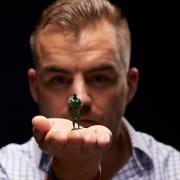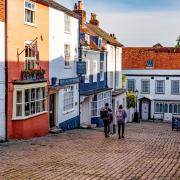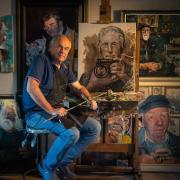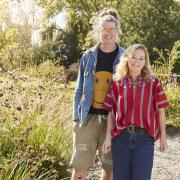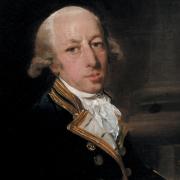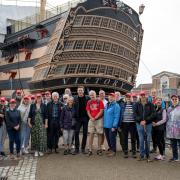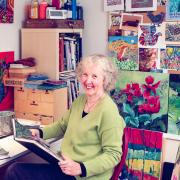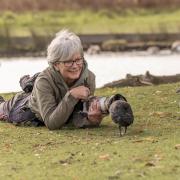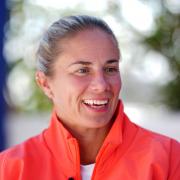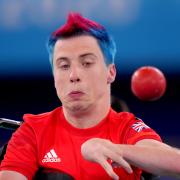After five decades, Lymington actress Sophie Neville shares her memories of playing the youngest Walker, Titty, in a film that is still loved by so many
‘My father, who grew up in Lymington, spent years racing yachts on the Solent, but I could only describe myself an able seaman. I was happy on the water, could row and help launch dinghies but that was about it.’ That was all however, it seems, that film producer Richard Pilbrow, needed from actress Sophie Neville, who this year is celebrating 50 years since the iconic film adaptation of Arthur Ransome’s story, Swallows and Amazons, was premiered.
‘Claude Whatham, the director, had previously cast me in the first BBC adaptation of Laurie Lee’s memoir, Cider With Rosie. He must have remembered me as a spirited little girl because a letter arrived in March 1973, inviting me to an interview in Shaftesbury Avenue. I was then asked to take part in a sailing audition at Burnham-on-Crouch. Being twelve years old, I was rather too old and too tall to play a nine-year-old really and Arthur Ransome's book illustrations portrayed girls with straight, dark hair. However, unbeknown to me, the widowed Mrs Ransome, a formidable Russian lady who had once been Trotsky's private secretary, wanted “an English Rose” to play Titty,’ so Sophie was formally offered the part with a contract arriving in the post.

The story of Swallows and Amazons is about a family of four children on holiday in the Lake District who are given permission to sail a dinghy called Swallow and camp on an island that can be seen from the farm where their mother is staying. They are confronted by two local girls, the Amazons, who are behaving badly. Their Uncle Jim had been ignoring them as he wanted to concentrate on writing his memoirs. The crisis point is reached when a trunk containing the draft of his book is stolen from his houseboat. No one believes Titty, the youngest girl, who is sure she heard the burglars. She rows Swallow to Cormorant Island and finds what looks like a treasure chest. It is returned to Uncle Jim – known as Captain Flint – but only after he is made to walk the plank.
Making a movie entirely on location was character-building stuff as Sophie remember: ‘Working under arc lamps with Dame Virginia McKenna, who played my mother, was inspirational, but the sailing sequences were difficult to set up. The film actress Suzanna Hamilton, who played my sister Susan, was brilliant. She anchored us, as did Simon West in the role of Captain John. He was a confident sailor who later won the National Optimist Championships.’
The Lake District's unpredictable weather made planning anything difficult and as Sophie explains: ‘Swallow's mast broke, we nearly crashed into a larger boat, and the film set was vandalised. Endless rainy days meant we over-ran by two weeks, but Virginia was stoic and brought us together as a team. I lost a tooth halfway through filming a scene with her on Peel Island, but somehow the challenges gave the finished film an enduring quality that made it into a classic.’

Sophie enjoyed the post-production work at Elstree Studios but disliked the fuss made around the cinema release in 1974.
‘Seeing yourself on camera always feels uncomfortable. The Royal Gala premiere of Swallows and Amazons was daunting. It was held at the ABC in Shaftesbury Avenue alongside The Exorcist.’
Like it or not, the young cast ended up promoting the movie on television and at the Lord Mayor’s Show.
Following the success of the film, at the age of fifteen, Sophie went on to play a leading part in an adventure film called The Copter Kids. She appeared in Crossroads and a series of The Two Ronnies that culminated with a scene shot on Southampton Docks, but she was not particularly interested in acting.
‘Once at university, I developed a burning desire to direct and went into television production, making my first documentary for Channel 4 whilst driving from London to Johannesburg. I began directing comedy dramas at the BBC but overdid it and was hammered by ill health,’ she remembers.

She returned to home to recover, keeping a diary that was later published under the title Funnily Enough. Self-published, it was placed in an international literary award and became a bestseller on Amazon Kindle in the UK. The sequel, Ride the Wings of Morning is partly set near Hook and Andover where her sisters live.
Sophie emigrated to southern Africa in 1992 where she set up wildlife documentaries and a summer series of Blue Peter. But after twelve years, Hampshire was calling, and she moved with her husband back to the New Forest where she was invited to become President of The Arthur Ransome Society. She was soon persuaded to give talks in Hampshire on how the 1974 feature film had been made.
‘When movie fans learned that I'd kept a diary on location they urged me to elucidate. I found behind-the-scenes photos taken by my Mum, drew maps of the lakes and brought out a multimedia ebook, The Secrets of Filming Swallows and Amazons. The paperback entitled The Making of Swallows and Amazons, published by The Lutterworth Press, is now available as an audiobook recorded at Monkeynut Studios near Romsey.’
Still popular 50 years on, Swallows and Amazons is currently available to stream on Amazon Prime, and Sophie has a few home-movie clips on her YouTube channel too.

‘Our news is that The Arthur Ransome Society now owns both the dinghies used in the film. We brought Swallow to the Southampton International Boat Show in 2022 and displayed Amazon there in 2023. Both will soon be available for families to take out from Hunter's Yard on the Norfolk Broads who hire out Lullaby, the vintage cabin cruiser featured in the BBC adaptation of Arthur Ransome’s book Coot Club, which I worked on behind the camera.’
‘Having been broadcast around the world, I'm assured the original movie Swallows and Amazons has been shown on television more times than any other British film. When I first published The Making of Swallows and Amazons, someone left an online review saying they thought it a good idea for a novel but that it was a bit far-fetched. The amazing thing was that my story was true.’





